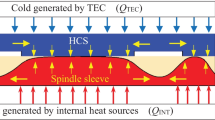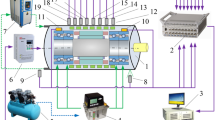Abstract
In view of the thermal declination of spindle system caused by the uneven heating, this paper proposed a thermal error reduction strategy by optimizing the thermal conductivity of the material. Firstly, according to the structural size and material characteristics of the spindle system, the thermal resistance and thermal contact resistance of each component are calculated, thereby establishing a spindle-housing thermal resistance network model and calculating temperature values of the key points. Then, heat conduction and insulation device are properly installed in the headstock, so that the heat in the high temperature zones can be quickly conducted to the low temperature zones, and the temperature field of the headstock is balanced. Finally, the multi-objective optimization method is used to optimize the size, material properties, and surface parameters of the device to achieve optimal heat balance. Verification was performed by numerical simulation and experiments. The results demonstrate that the thermal conductivity optimization strategy can effectively improve the temperature nonuniformity of the headstock and reduce the thermal tilt of the spindle.
















Similar content being viewed by others
References
Mayr J, Jedrzejewski J, Uhlmann E et al (2012) Thermal issues in machine tools. CIRP Ann Manuf Technol 61(2):771–791
Krulewich DA (1998) Temperature integration model and measurement point selection for thermally induced machine tool errors. Mechantronics 8:395–412
Su H, Lu L, LIang Y et al (2014) Thermal analysis of the hydrostatic spindle system by the finite volume element method. Int J Adv Manuf Technol 71(9):1949–1959
Bossmanns B, Tu J (1999) A power flow model for high speed motorized spindles. Int J Mach Tools Manuf 39(9):1345–1366
Lin C-W, Tu J, Kamman J (2003) An integrated thermo-mechanical-dynamic model to characterize motorized machine tool spindles during very high speed rotation. Int J Mach Tools Manuf 43:1035–1050
Jorgensen B, Robust modeling of high-speed spindle bearing dynamics under operating conditions, Ph.D. (1996) Thesis. Purdue University, West Lafayette
Brecher C, Shneor Y, Neus S et al (2015) Thermal behavior of externally driven spindle: experimental study and modelling. Engineering 7:73–92
Jian L, Kim DH, Lee CM (2015) A study on the thermal characteristics and experiments of high-speed spindle for machine tools. Int J Precis Eng Manuf 16:293–299
Zhao H, Yang J, Shen J (2007) Simulation of thermal behavior of a CNC machine tool spindle. Int J Mach Tools Manuf 47(6):1003–1010
Li Y, Zhao W, Wu W, Lu B (2017) Boundary conditions optimization of spindle thermal error analysis and thermal key points selection based on inverse heat conduction. Int J Adv Manuf Technol 90(9–12):2803–2812
Zhang L, Gong W, Zhang K (2018) Thermal deformation prediction of high-speed motorized spindle based on biogeography optimization algorithm. Int J Adv Manuf Technol 97:3141–3151
Ma C, Yang J, Zhao L, Mei XS, Shi H (2015) Simulation and experimental study on the thermally induced deformations of high-speed spindle system. Appl Therm Eng 86:251–268
Liu Z, Pan M et al (2015) Thermal characteristic analysis of high-speed motorized spindle system based on thermal contact resistance and thermal-conduction resistance. Int J Adv Manuf Technol 76:1913–1926
Kim SM, Lee SK (2005) Spindle housing design parameter optimization considering thermo-elastic behavior. Int J Adv Manuf Technol 25(11):1061–1070
Mori M, Mizuguchi H, Fujishima M et al (2009) Design optimization and development of CNC lathe headstock to minimize thermal deformation. CIRP Ann 58(1):331–334
Moon BJ, Kim J, Lee SK (2015) Suppression of thermal crown of heating roll for large area thermal imprint with consideration of thermal resistance between roll and shaft. Int J Precis Eng Manuf Green Technol 2(4):315–323
Bae GT, Kim GN, Choi BY et al (2015) Shape optimization of grinding spindle using response surface analysis. J Ocean Eng Technol 29(1):56–61
Brecher C, Utsch P, Wenzel C (2009) Five-axis accuracy enhancement by compact and integral design. CIRP Ann Manuf Technol 58(1):355–358
Brecher C, Utsch P, Klar R, Wenzel C (2010) Compact design for high precision machine tools. Int J Mach Tools Manuf 50:328–334
Donaldson RR, Thompson DC (1986) Design and performance of a small precision CNC turning machine. Ann CIRP 35(1):373–376
Axinte DA, Abdul Shukor S, Bozdana AT (2010) An analysis of the functional capability of an in-house developed miniature 4-axis machine tool. Int J Mach Tools Manuf 50:191–203
Neugebauer R, Drossel W-G, Ihlenfeldt S, Nestmann S, Richter C.(2012) Inherent Thermal Error Compensation of Machine Tool Structures with Graded Mineral Casting, MATAR2012-12053, MM Science Journal. 9th Inter-national Conference on Machine Tools, Automation, Technology and Robotics, 12–14, Prague, Czech Republic.
Abdulshahed AM, Longstaff AP, Fletcher S (2015) The application of ANFIS prediction models for thermal error compensation on CNC machine tools. Appl Soft Comput 27:158–168
Mohring H-C, Brecher C et al (2015) Materials in machine tool structures. Manuf Technol 64:725–748
Funding
This paper is sponsored by the “Technology of on-line monitoring system for thermal characteristics of NC machine tools” (No. H2019304021); the “Project funded of Shanghai science committee- Precision technology and its application for five-axis machine tool based on the real-time compensation” (NO. J16022).
Author information
Authors and Affiliations
Corresponding author
Additional information
Publisher’s note
Springer Nature remains neutral with regard to jurisdictional claims in published maps and institutional affiliations.
Rights and permissions
About this article
Cite this article
Zhou, H., Fan, K. & Gao, R. Fast heat conduction-based thermal error control technique for spindle system of machine tools. Int J Adv Manuf Technol 107, 653–666 (2020). https://doi.org/10.1007/s00170-020-04961-3
Received:
Accepted:
Published:
Issue Date:
DOI: https://doi.org/10.1007/s00170-020-04961-3




